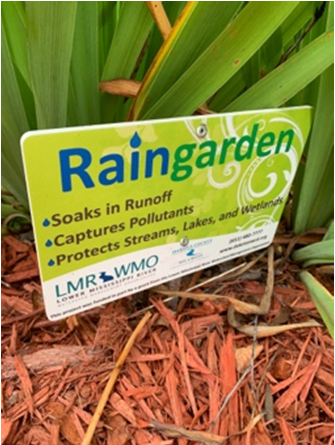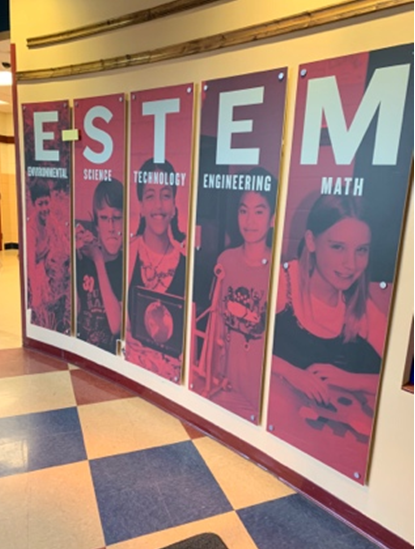Beginning the Journey to Creating an E-STEM School
Categories From the first time I walked into my current school its originality was so apparent, like no other school, and after four years that authenticity endures. Approaching the main entrance, I was greeted with a sign saying “Rain garden” next to another informing “Our lawns have an adjusted schedule to promote pollinator growth.” A leopard gecko watched over the main entrance from its window, and while I awaited a first meeting with my new principal some “Nemos” entertained me in the main office fish tank. These were just some of the indications that really got me excited to start a new path at my E-STEM school where we are making a commitment to environmental awareness.
From the first time I walked into my current school its originality was so apparent, like no other school, and after four years that authenticity endures. Approaching the main entrance, I was greeted with a sign saying “Rain garden” next to another informing “Our lawns have an adjusted schedule to promote pollinator growth.” A leopard gecko watched over the main entrance from its window, and while I awaited a first meeting with my new principal some “Nemos” entertained me in the main office fish tank. These were just some of the indications that really got me excited to start a new path at my E-STEM school where we are making a commitment to environmental awareness.
 Concerns of climate change, environmental pollution and global warming have led a movement toward practices in our daily lives to protect our world. We see it every day in the ways we live whether through recycling, purchasing of environmentally sustainable products, driving of hybrid and electric vehicles or use of recyclable bags at the grocery store. I have always tried to live an environmentally friendly life and am proud to be the first neighbor on my block to maintain a bee-friendly garden. But often it just doesn’t feel like we are doing enough, and that nagging feeling was what brought me to start a new job teaching at an E-STEM school. I felt if I could impact students and grow their awareness I would be fueling a new generation to strive for a healthy environment.
Concerns of climate change, environmental pollution and global warming have led a movement toward practices in our daily lives to protect our world. We see it every day in the ways we live whether through recycling, purchasing of environmentally sustainable products, driving of hybrid and electric vehicles or use of recyclable bags at the grocery store. I have always tried to live an environmentally friendly life and am proud to be the first neighbor on my block to maintain a bee-friendly garden. But often it just doesn’t feel like we are doing enough, and that nagging feeling was what brought me to start a new job teaching at an E-STEM school. I felt if I could impact students and grow their awareness I would be fueling a new generation to strive for a healthy environment.
 Understanding the focus and purpose of STEM education is the first step toward implementing an E-STEM community of learners within a district, school and classrooms. STEM is a curriculum based on the idea of educating students in four specific disciplines - science, technology, engineering and mathematics - in an interdisciplinary and applied approach. Rather than teach the four disciplines as separate and discrete subjects, STEM integrates them into a cohesive learning paradigm based on real-world applications. The past decade has witnessed an undertaking to create and sustain STEM schools to prepare learners for a changing need in the demand for jobs in those areas. This push was the result of government actions from the Obama administration in 2009 under the “Educate to Innovate” campaign. Progressively the campaign expanded funding to STEM educational programs and agencies.
Understanding the focus and purpose of STEM education is the first step toward implementing an E-STEM community of learners within a district, school and classrooms. STEM is a curriculum based on the idea of educating students in four specific disciplines - science, technology, engineering and mathematics - in an interdisciplinary and applied approach. Rather than teach the four disciplines as separate and discrete subjects, STEM integrates them into a cohesive learning paradigm based on real-world applications. The past decade has witnessed an undertaking to create and sustain STEM schools to prepare learners for a changing need in the demand for jobs in those areas. This push was the result of government actions from the Obama administration in 2009 under the “Educate to Innovate” campaign. Progressively the campaign expanded funding to STEM educational programs and agencies.
 Environmental Science, Technology, Engineering and Math (E-STEM) education is a newer initiative. This adds an additional layer of complexity to the STEM curriculum. While an E-STEM school follows most of the same practices as the STEM model, the environmental concern and impact are at the core of the curriculum of the four interdisciplinary subjects. Communities of teachers, whether by grade level, teams/houses, or subject area start with a deep-thinking question related to the environment. For example, the 5th grade team at our school comprised of Social Studies, Language Arts, Science, and Math uses the question “How do the products we use daily impact the earth?” This allows for multiple responses and the ability to experiment and analyze data. The key to this question is that there isn’t one correct response so it allows for greater thinking, which then generates more questions for the students to think about critically. Students employ the scientific process to gather information, create a hypothesis, experiment and synthesize their findings. This process is utilized across content areas with experimentation in Science, data collection using mean, median and mode in Math, analysis of current events that may impact government action and environmental laws that exists in Social Studies, and creation of a scientific report using grade appropriate informational writing standards in Language Arts. While this may be an oversimplification of the process the most important difference to other STEM curriculums is that environmental learning comprises the essential components of the learning process.
Environmental Science, Technology, Engineering and Math (E-STEM) education is a newer initiative. This adds an additional layer of complexity to the STEM curriculum. While an E-STEM school follows most of the same practices as the STEM model, the environmental concern and impact are at the core of the curriculum of the four interdisciplinary subjects. Communities of teachers, whether by grade level, teams/houses, or subject area start with a deep-thinking question related to the environment. For example, the 5th grade team at our school comprised of Social Studies, Language Arts, Science, and Math uses the question “How do the products we use daily impact the earth?” This allows for multiple responses and the ability to experiment and analyze data. The key to this question is that there isn’t one correct response so it allows for greater thinking, which then generates more questions for the students to think about critically. Students employ the scientific process to gather information, create a hypothesis, experiment and synthesize their findings. This process is utilized across content areas with experimentation in Science, data collection using mean, median and mode in Math, analysis of current events that may impact government action and environmental laws that exists in Social Studies, and creation of a scientific report using grade appropriate informational writing standards in Language Arts. While this may be an oversimplification of the process the most important difference to other STEM curriculums is that environmental learning comprises the essential components of the learning process.
 Throughout this series I would like to explore what E-STEM is at the core of its practice, steps involved in the implementation of an E-STEM school or class, and a guiding framework utilized in the E-STEM classroom setting.
Throughout this series I would like to explore what E-STEM is at the core of its practice, steps involved in the implementation of an E-STEM school or class, and a guiding framework utilized in the E-STEM classroom setting.
Here are a few classes related to this topic:
 Integrating STEAM into your Curriculum
Integrating STEAM into your Curriculum
 Teaching Algebra with Technology
Teaching Algebra with Technology
 21st-Century Learners: Reaching and Teaching the iGeneration
21st-Century Learners: Reaching and Teaching the iGeneration